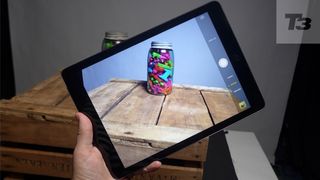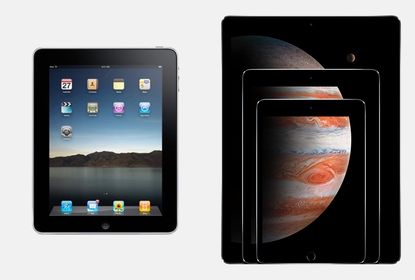The iPad hasn't yet hit its sixth birthday but it's difficult to imagine life without this svelte Apple tablet. From a hugely successful initial launch, to various attempts at reinvention, to the launch of this year's humongous iPad Pro, here's the history of the iPad as it stands today.
iPad (2010-2012)

After months of hype and speculation, the very first iPad was announced on 27 January 2010 by Steve Jobs - apparently Jony Ive had been working on it since before Apple committed itself to the iPhone. Measuring 9.7 inches diagonally, it had a 1024 x 768 pixel resolution and came with iOS 5.1.1.
It was a huge success, with Apple selling a million units in two months (half the time it took to sell a million of the original iPhones). The thinner, lighter, curvier and faster iPad 2 was unveiled in March 2011, and added front and rear cameras so users could start snapping photos with their tablets.
The iPad 3 (released March 2012, shown above) and the iPad 4 (released October 2012) improved the slate's internal specs but also boosted the screen resolution to 2048 x 1536 pixels, the same as the newest iPad Air 2. The tablets were still getting thinner and lighter but sales were plateauing - Apple needed a different iPad trick to win over a new swathe of buyers...
iPad mini (2012-2015)

...and that trick was the iPad mini. Once hailed as the saviour of the iPad line, the smallest version has recently been squeezed out of favour by smartphones that are getting bigger and bigger (cough cough iPhone 6s Plus) and these days it doesn't take up much time at Apple media events.
We saw our first iPad mini (pictured above) in October 2012, launched alongside the iPad 4 and offering 1024 x 768 pixels spread across a 7.9-inch display. The next year it got a significant upgrade, with the introduction of a Retina display (2048 x 1536 pixels to match the main iPads).
Since that big spec bump, Apple seems to have lost interest: the iPad mini 3 launched in October 2014 had exactly the same hardware as its predecessor, though Touch ID was added to the mix. The mini 4, shown off alongside the iPad Pro earlier this month, does have improved components inside it but otherwise sticks to the same design and screen resolution formula.
iPad Air (2013-2014)

The first iPad Air (pictured above) was strictly speaking the iPad 5, but as it shaved another 2mm off the thickness Apple decided to rebadge it (and a new name often works wonders in terms of sales of course). It was shown off to the world by Tim Cook in October 2013.
The display size stayed the same from the iPad 4, though the internal components did get an upgrade, and there was the extra thinness we mentioned earlier. The side bezels reduced in size too, marking the first real cosmetic design change for the iPad since the iPad 2.
The most recent iPad Air is the iPad Air 2, launched back in October 2014 - this part of the iPad line-up didn't get a refresh this year. The differences between the iPad Air and the iPad Air 2 are mostly under the hood: a small CPU speed increase, a doubling of the RAM, and improved graphics capabilities. The screen size and resolution remained the same.
iPad Pro (2015)

The biggest iPad story of 2015 is of course the iPad Pro, shown off at the start of September with much fanfare from Apple and its executives on stage at the Bill Graham Civic Auditorium. Like the mini, it's aiming to revitalise flagging iPad sales, but it's gone in the opposite direction in terms of size.
The screen measures a huge 12.9 inches from corner to corner for a start, while the resolution is 2732 x 2048 pixels (for a total of some 5.6 million). It comes with a new A9X CPU that Apple says is about 2.5x faster than the original iPad Air with 5x the graphics power.
It's really the accessories that tell you all you need to know about Apple's plans for its latest iPad. The Smart Keyboard cover lets you turn the iPad Pro into a MacBook alternative, while the Pencil stylus lets you turn it into a graphics tablet as well. With the Split View mode available in iOS 9, this is designed as a serious productivity machine.



